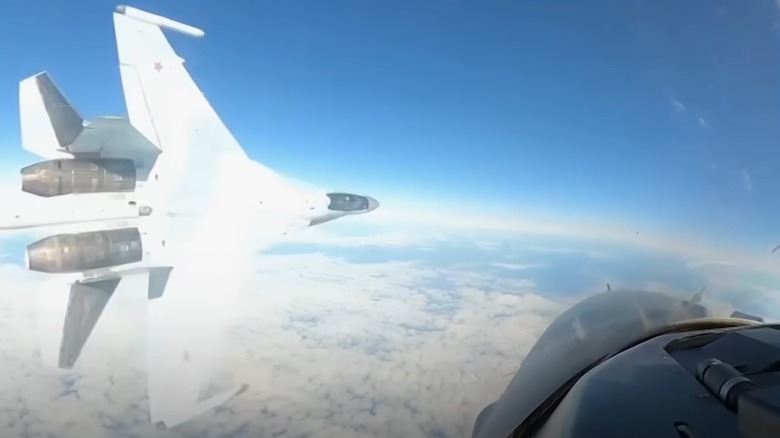What Does It Mean When A Fighter Jet Rocks Its Wings?
Aircraft communicate with one another in multiple ways. Contacting another pilot via radio is the most straightforward choice, but what about when the radio is inoperable or inconsistent? That's when pilots use official visual indicators — including hand or head motions, flashing lights, or aircraft movement — to describe a variety of circumstances.
Imagine a situation where a fighter pilot wanders across another country's border without authorization. If no communication with air traffic control has transpired, such as a jet squawking 7700, a pair of fighter jets will likely be scrambled to investigate. This situation can be considered an emergency, as those on the ground are unsure of the intruding pilots' intentions. Therefore, it's not unheard of for intercepting fighter jets to go supersonic to catch up to the unidentified aircraft, and when these jets supercruise, the result is an ear-shattering sonic boom.
The U.S. military's intercept procedure usually involves two intercepting jets approaching the unidentified aircraft from the rear. One jet flanks the plane to see its pilot, and the other follows behind in a formation meant to communicate that it has been officially intercepted. At this point, the pilot of the offending craft should tilt or rock their jet's wings from side to side, showing they understand the situation. If it's nighttime, they should also blink their navigation lights.
Intercepts as a means of intimidation
Intercepts happen frequently around the world, usually ending in a simple escort out of the area. For example, the joint U.S.-Canadian military command NORAD says it intercepts an average of six or seven Russian military aircraft every year that have drifted into restricted airspace around Alaska. While typically these situations are handled without incident, some contacts have been less cordial, such the one this September pictured above, where a Russian jet came dramatically close to an American F-16.
In another part of the world, while U.S. Navy P-8A patrol planes were flying over a section of the Mediterranean Sea in 2022, two Russian Su-35 jets intercepted them. But instead of remaining a safe distance away, the Russian pilots got dangerously close, coming within 5 feet — and there were two other cases of reckless contact between U.S. and Russian jets around the same time. Flying so close to other aircraft opens up the possibility of a collision, and introduces risk factors such as wake turbulence and exhaust exposure.
Tension among America and Russia goes back decades, and the U.S. feared Soviet fighter jets during the Cold War. Retired U.S. Navy Cmdr. Guy Snodgrass, a veteran pilot and Top Gun trainer, told Business Insider: "Russia has had a history over the decades of performing incredibly aggressive intercepts as a way of intimidating the aircrews or trying to get those aircrews to leave the area."

